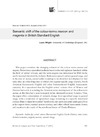Identificador persistente para citar o vincular este elemento:
https://accedacris.ulpgc.es/handle/10553/9728
| DC Field | Value | Language |
|---|---|---|
| dc.contributor.author | Wright, Laura | en_US |
| dc.date.accessioned | 2013-02-28T06:00:32Z | - |
| dc.date.accessioned | 2018-03-15T14:30:17Z | - |
| dc.date.available | 2013-02-28T06:00:32Z | - |
| dc.date.available | 2018-03-15T14:30:17Z | - |
| dc.date.issued | 2011 | en_US |
| dc.identifier.issn | 1133-1127 | en_US |
| dc.identifier.uri | https://accedacris.ulpgc.es/handle/10553/9728 | - |
| dc.description.abstract | This paper considers the changing referent of the colour terms maroon and magenta. Maroon was a specialised technical term in the mid-eighteen-hundreds within the field of artists’ colours, and the term magenta was introduced in 1860 in the newly-invented chemical dye industry. Both terms spread out into general usage, and in the case of maroon, caused earlier meanings to be disturbed and displaced so that today they are either forgotten or shifted into register-specific usage (namely, North American bureaucratic English and other Extraterritorial English bureaucratic varieties). It is speculated that the English artists’ colours firm of Winsor and Newton had a role in retarding the American sense-development of the colour term maroon, as this firm had a near-monopoly in late nineteenth-century America. Thus, the paper offers a description of semantic change from specialised usage to general usage, with a restriction of specialised usage remaining in a specific functional context. Data is taken from artists’ handbooks, tint-cards and paint catalogues; from police report forms, wanted persons notices, and other official bureaucratic forms; and mention is also made of the novels and letters of Charles Dickens. | en_US |
| dc.format | application/pdf | es |
| dc.language | eng | en_US |
| dc.relation.ispartof | LFE. Revista de Lenguas para Fines Específicos | en_US |
| dc.source | LFE. Revista de lenguas para fines específicos. Las Palmas de Gran Canaria: Universidad de Las Palmas de Gran Canaria, 1993 [ISSN 1133-1127] n. 17, 2011, p. 341-374 | en_US |
| dc.subject | 570107 Lengua y literatura | en_US |
| dc.subject | 550510 Filología | en_US |
| dc.subject.other | Bureaucratic English | en_US |
| dc.subject.other | Charles Dickens | en_US |
| dc.subject.other | Aniline dye | en_US |
| dc.title | Semantic shift of the colour-terms maroon and magenta in British Standard English | en_US |
| dc.type | info:eu-repo/semantics/article | en_US |
| dc.type | Article | en_US |
| dc.compliance.driver | 1 | es |
| dc.identifier.absysnet | 233536 | - |
| dc.investigacion | Artes y Humanidades | en_US |
| dc.rights.accessrights | info:eu-repo/semantics/openAccess | es |
| dc.type2 | Artículo | en_US |
| dc.identifier.ulpgc | Sí | es |
| dc.description.esci | ESCI | |
| dc.description.erihplus | ERIH PLUS | |
| item.fulltext | Con texto completo | - |
| item.grantfulltext | open | - |
| Appears in Collections: | LFE, Rev. leng. fines específ. n.17, 2011 Artículos | |
Page view(s)
45
checked on Jan 27, 2024
Download(s)
249
checked on Jan 27, 2024
Google ScholarTM
Check
Share
Export metadata
Items in accedaCRIS are protected by copyright, with all rights reserved, unless otherwise indicated.
